An important report economic modelling report commissioned by the US Department of Energy (DOE, which will determine the extent of LNG exports) has concluded that there is no senario in which the US does accrue net benefits from expanding its LNG exports. The report by NERA is available in full here.
It’s conclusions are as follows:
NERA developed a Global Natural Gas Model (“GNGM”) and a general equilibrium model of the U.S. economy (“NewERA Model”) to evaluate feasible levels of LNG exports and their impacts on the U.S. economy. These two models allowed us to determine feasible export levels, characterize the international gas market conditions, and evaluate overall macroeconomic effects. Given the wide range in export expansion outcomes, it is not surprising to find great variation in the macroeconomic impacts and natural gas market changes. Nevertheless, several observations may be distilled from the patterns that emerged.
A. LNG Exports Are Only Feasible under Scenarios with High International Demand and/or Low U.S. Costs of Production
Under status quo conditions in the world and the U.S. (U.S. Reference and International Reference cases) there is no feasible level of exports possible from the U.S. Under the low natural price case (High Shale EUR), LNG exports from the U.S. are feasible. However, under a low shale gas outlook (Low Shale EUR), international demand has to increase along with a tightening of international supply for the U.S. to be an LNG exporter.
B. U.S. Natural Gas Prices Do Not Rise to World Prices
LNG exports will not drive the price of domestic natural gas to levels observed in countries that are willing to pay oil parity-based prices for LNG imports. U.S. exports will drive prices down in regions where U.S. supplies are competitive so that even export prices will come down at the same time that U.S. prices will rise. Moreover, basis differentials due to transportation costs from the U.S. to high-priced regions of the world will still exist, and U.S. prices will never get closer to those prices than the cost of liquefaction plus the cost of transportation to and regasification in the final destination. Thus even in the scenarios with no binding export levels, the wellhead price in the U.S. is below the import price in Japan, where the U.S. sends some of its exports. The largest change in international natural gas prices in 2015 and 2025 is about $0.33/MMBtu and $1/MMBtu, respectively. These increases occur only in highly stressed conditions or when global markets are willing to take the full quantities of export volumes at prices above marginal production cost in the U.S. plus liquefaction, transportation, and regasification costs incurred to get the LNG to market.
C. Consumer Well-being Improves in All Scenarios
The macroeconomic analysis shows that there are consistent net economic benefits across all the scenarios examined and that the benefits generally become larger as the amount of exports increases. These benefits are measured most accurately in a comprehensive measure of economic welfare of U.S. households that takes into account changes in their income from all sources and the cost of goods and services they buy. This measure gives a single indicator of relative overall well-being of the U.S. population, and it consistently ranks all the scenarios with NERA Economic Consulting 77 LNG exports above the scenario with No-Exports. Welfare improvement is highest under the high export volume scenarios because U.S. consumers benefit from an increase in wealth transfer and export revenues.
D. There Are Net Benefits to the U.S. A related measure that shows how economic impacts are distributed over time is GDP. Like welfare, GDP also increases as a result of LNG exports. The most dramatic changes are in the short term, when investment in liquefaction capacity adds to export revenues and tolling charges to grow GDP. Under the Reference case, GDP increases could range from $5 billion to $20 billion. Under the High Shale case, GDP in 2020 could increase by $10 billion to $47 billion. Under the Low Shale case, GDP in 2020 could increase by $4.4 billion. Every scenario shows improvement in GDP over the No-Exports cases although in the long run the impact on GDP is relatively smaller than in the short run. Although the patterns are not perfectly consistent across all scenarios, the increase in investment for liquefaction facilities and increased natural gas drilling and production provides, in general, near-term stimulus to the economy. At the same time, higher energy costs do create a small drag on economic output in the U.S. so that total worker compensation declines.
E. There Is a Shift in Resource Income between Economic Sectors
The U.S. has experienced many changes in trade patterns as a result of changing patterns of comparative advantage in global trade. Each of these has had winners and losers. Grain exports raised the income of farmers and transferred income from U.S. consumers to farmers, steel imports lowered the income of U.S. steel companies and lowered costs of steel for U.S. manufacturing, etc. The U.S. economy will experience some shifts in output by industrial sectors as a result of LNG exports.
Compared to the No-Exports case, incomes of natural gas producers will be greater, labor compensation in the natural gas sector will increase while other industrial sector output and labor compensation decreases. The natural gas sector could experience an increase in production by 0.4 Tcf to 1.5 Tcf by 2020 and 0.3 Tcf to 2.6 Tcf by 2035 to support LNG exports. The LNG exports could lead to an average annual increase in natural export revenues of $10 billion to $30 billion.
Impacts on sectoral output vary. Manufacturing sector output decreases by less than 0.4% while EIS and electric sector output impacts could be about 1% in 2020 when the natural gas price is the highest. Changes in industry output and labor compensation are very small. Even energy-intensive sectors experience changes of 1% or less in output and labor compensation during the period when U.S. natural gas prices are projected to rise more rapidly than in a No-Exports case. Harm is likely to be confined to narrow segments of the industry, and vulnerable industries are not high value-added industries.
The electricity sector, energy-intensive sector, and natural gasdependent goods and services producers will all be impacted by price rises. Conversely, natural gas suppliers will benefit. Labor wages will likewise decrease or increase, respectively, depending on the sector of the economy.
So, the study sees net benefits to growth:
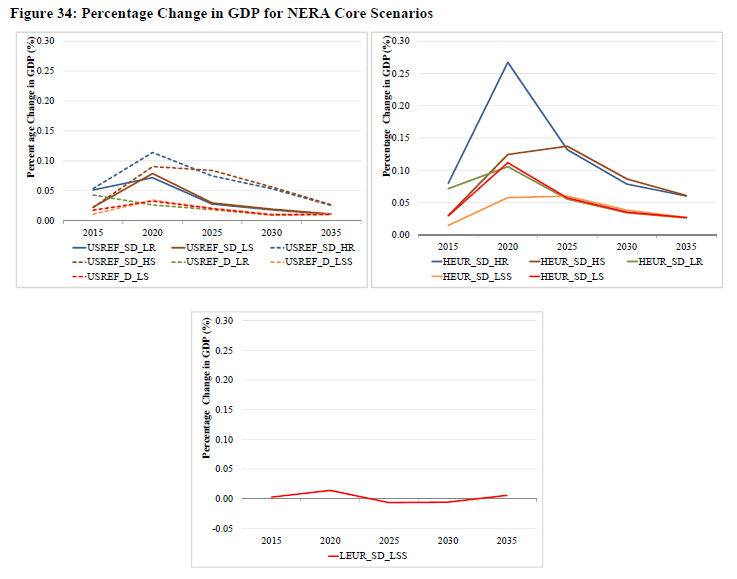
Net benefits to welfare:
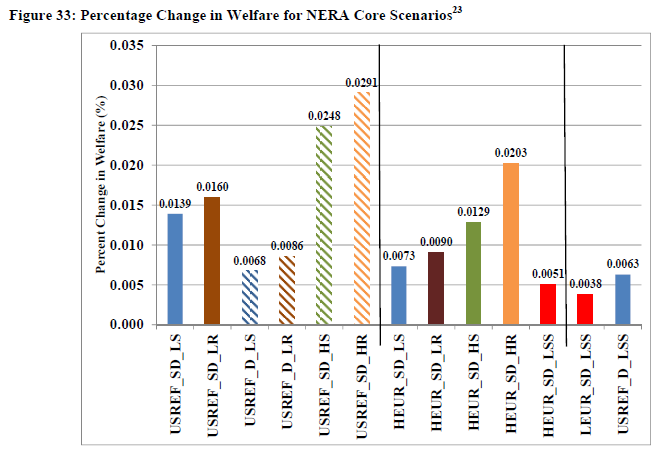
And, for the most part, ongoing low gas prices:
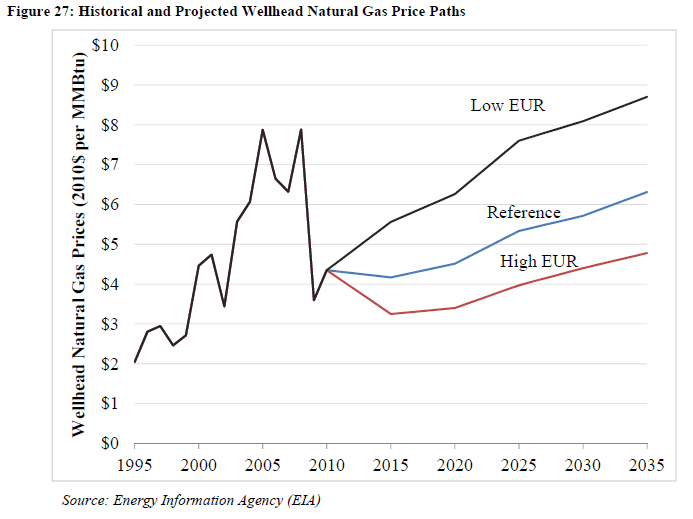
These headline results of the study are not encouraging for Australia insofar as they give a clear green light to US LNG exports. But a deeper reading of the report is less bearish. Athough international prices will fall, the report suggests Australian LNG would remain competitive.
For instance, here is the reports liquifaction plant investment costs by region, where we are very expensive:
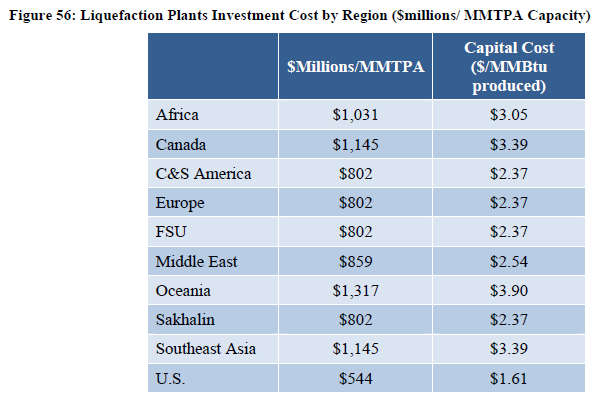
The same is true in operational liquifaction costs:
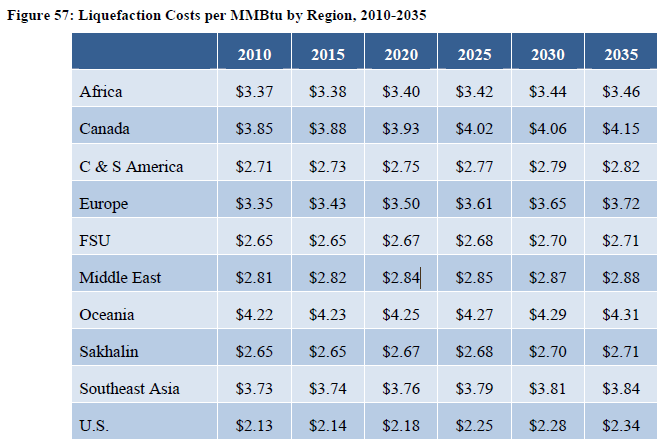
But then add wellhead prices and the situation reverses:
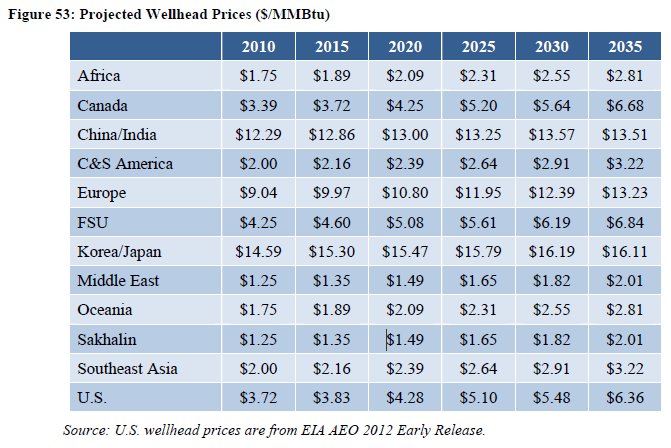
And shipping is the same:
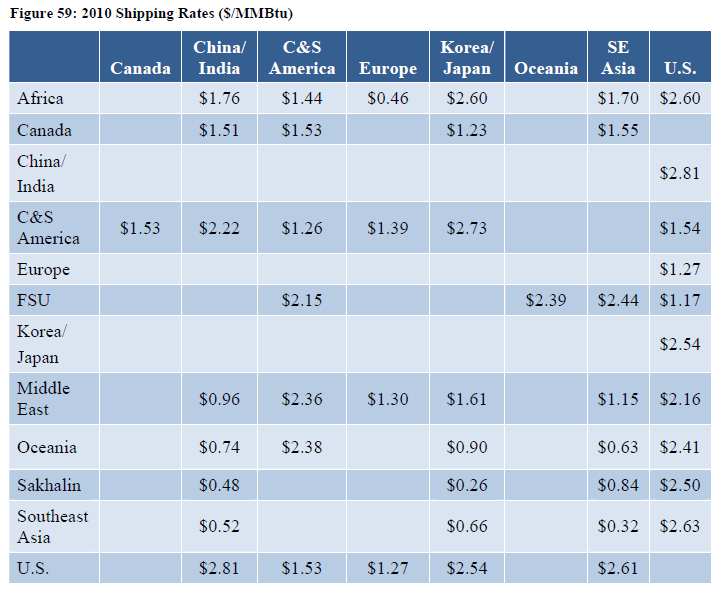
You can add another $1 or so for regasification for everyone and the back of envelope suggests US gas would hit Japan at current prices between $9-10, whereas Australian gas would arrive around a dollar cheaper.
So, current Australian LNG projects do not get displaced by US gas, assuming they all fall under these costs. The other point to note is that these costs show why US exports only transpire in the high demand or high production scenarios. Any lower and it’s just not economic.
But! In commodity investment the iron law is the cheapest gets developed first so presuming that the US DOE follows the dictates of its own report, then all future Australian projects must now be in serious doubt. Moreover, the one thing that the report makes very clear is that US exports clearly cap the blue sky potential for LNG prices. There is now a gigantic swing producer sitting just above Australia’s primary cost curve, ready to pump the moment prices warrant it.

